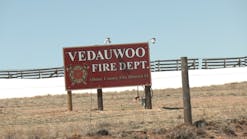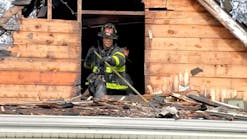Alternative fire suppression systems are common in many commercial buildings throughout the United States. Wet-chemical, dry chemical, systems utilizing foam, clean agent, and carbon dioxide suppression systems fall under the general classification of alternative suppression systems. Many of these systems are designed to protect a specific hazard and may be used to supplement an overall sprinkler system or provide protection in a sensitive area. The first step in ensuring proper protection is the agent's compatibility with the protected hazard. Alternative fire protection systems will protect a specific hazard when water is not a key suppression agent. This article will review some of the basic concepts of three of these types of alternative fire suppression systems; wet chemical, dry chemical, and foam suppression systems.
Wet Chemical Systems
Wet Chemical fire suppression systems are typically pre-engineered based on typical hazards that are presented in kitchen cooking line ups. Wet chemical suppression systems are required in kitchen cooking areas where a type I hood is required by a mechanical code. The design and installation of wet chemical systems is based on the requirements of UL 300, National Fire Protection Association 17a Standard for Wet Chemical Extinguishing Systems, and the manufacture specifications. Contractors are typically approved by the manufacture of the system to design and install the system based on pre-approved or pre-engineered requirements found in the manufacture requirements.
The suppression system provides nozzles which discharge the suppression agent in the duct work, plenum space, and the cooking surface. Typically all cooking equipment is protected with a specific nozzle configuration except enclosed ovens. The system includes a suppression tank, piping, and nozzles. The size of the tank is based on the number of flow points (typically related to the number and size of the nozzle) located in the system. The number of appliances, size of the hood, and plenum are the basis for the number of nozzles needed. Each manufacture specifies a specific nozzle type and location for a specific cooking appliance. Nozzles are very specific to the manufacture and can are not designed to be interchanged between manufactures.
The systems are activated automatically or manually. Automatic activation is created by a series of fusible links (located in the plenum space over each appliance and duct opening) connected to a releasing mechanism. One the heat reaches the predetermined temperature the link is released which activates the system. The system will discharge through all nozzles until the cylinder is empty. The manual activation is created by pulling a pull station which is located near the hood and on the way to the exit.
The systems are tested by a wet chemical discharge test. The contractor will use a test chemical and activate the system manually or simulate the releasing of a fusible link. The system will then discharge agent through all nozzles which is collected. The inspector should look for leakage at all joints and ensure agent has been discharged through all nozzles. Many communities are accepting a "puff-test" which utilizes air in lieu of an agent.
Dry Chemical Systems
Dry Chemical fire suppression systems utilize a dry chemical which discharge through a series of pipe and terminate in a nozzle. The systems can be classified as total flooding, local application, and can even include hose-line based system. The systems can be found protection fuel pump islands, paint spray booths, and may include special industrial processes. The systems are typically pre-engineered for the hazard they will protect by the manufacture and tested by an approved listing company. The protection of a paint spray booth is a typical application and the manufacture's installation and design instructions will outline the appropriate length or size of pipe, number of elbows or tees, and the type of nozzle for the space. The designer will submit plans for approval within the specifications of the manufacture and include information in accordance with National Fire Protection Association 17 Standard for the Installation of Dry-Chemical Extinguishing Systems.
These systems activate similar to wet-chemical suppressions systems either automatically or manually. Suppression is also provided in all spaces including the work area, plenum, and exhaust duct. Systems are to be inspected and tested on six month intervals. These testes are typically conducted by an approved contractor and a test report is submitted to the municipality and owner. The testing and inspection will include the detection devices, alarm components, releasing mechanisms, evaluation of extinguishing agent, and overall system operations.
Foam Systems
Foam Systems are based on three applications: low, medium, and high expansion foam systems. During the plan review process, the designer must evaluate the hazard and apply the appropriate type of system to the hazard that will be protected. Similar to fire fighting foam the appropriate type of foam must be applied to the anticipated fire. When comparing foam suppression systems to fire fighting operations, AFFF foam would be used by responding apparatus on a fire involving flammable liquids. The apparatus may use an in line inductor or a tanks systems permanently mounted to the apparatus. AFFF would not be used well in a fire involving class A materials. The same basic principles hold true for fixed foam suppression systems.
Foam systems utilize water and foam (at the appropriate concentrate for the hazard and system) to extinguish a fire. The use of combination foam / sprinkler systems can be utilized in the protection of flammable and combustible liquid warehouses. Medium and High Expansion foam system could be utilized to provide a blanket of foam over a hazard or even fill a complete space.
Code enforcement staff must ensure the foam system is appropriate for the hazard that will be protected. This will include a close coordination with the project engineer, installing contractor, and the occupant of the space. A thorough evaluation of the target hazard must be conducted and the application of foam must be approved. Typically the sprinkler system engineer will provide specifications for the system including piping layout, equipment, and foam system specifics. The submittal must include the basis for the design and information on the hazard. During the review or inspection process the manufacture's technical staff can be a great asset to fire prevention staff during the plan review and acceptance testing.
Responding to a System Activation
Crews that respond to activated suppression systems must be familiar with the capabilities of a system. Working with fire prevention staff, responding crews can learn where the systems are installed and what the capabilities are. This information for system activation, location of critical equipment, and protected areas should be indicated on pre-incident surveys. Operations in areas where systems have discharged must include full PPE with SCBA and face piece.
Crews that have responded to activated systems must work closely with adopted policies of the department. Policies should address fire extinguishment, extension, proper notification of fire prevention staff, and limitations on the owner. Buildings or operations should not be allowed to continue to operate with impaired systems without approval of the fire prevention bureau. Alternative fire suppression systems are key in protecting processes or hazards found in our communities.
Related Links: Wet Chemical Suppression Systems
- Ansul Restaurant Fire Suppression Systems
- Pyro-Chem Kitchen Knight II Restaurant Systems
- National Association of Fire Equipment Distributors UL-300 Standard Update
- State of Louisiana Chemical Fire Supression System Review Checklist & Fee Schedule
- Chesterfield, VA, Fire and EMS Wet Chemical Extinguishing System Paperwork
- Kiddie WHDR Wet Chemical Systems
Related Links: Dry Chemical Suppression Systems
- Fire Safety and Fire Extinguishers
- Ansul Industrial Systems
- Pyro-Chem Monarch Industrial Fire Protection
Related Links: Foam Systems
- Ansul Firefighting Foam Products
- Chemguard
- Madison, WI, Fire Department Fire Protection Systems Plans
Michael O'Brian has a varied career in the public and private sectors with an emphasis on code administration and enforcement for the last 10 years. Currently he is working for Farmington Hills, MI, Fire Department as a Staff Lieutenant and is the president of Code Savvy Consultants, a municipal plan review and consulting company.
He is the creator of a dynamic web page called www.inspector911.com which is designed to assist local inspectors by providing resources, information, checklists and up to date news. He has a bachelor of science degree in public safety administration from Eastern Michigan University and can be reached via email at [email protected]





